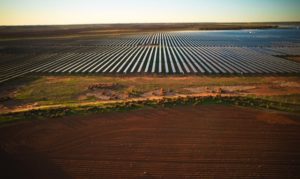Update: See AEMC delays decision on proposed changes to marginal loss factors
Investors who together account for more than $11 billion in renewable energy investments in Australia have warned that billions of dollars of new wind and solar projects are at risk without significant changes to the way transmission pricing is handled in this country.
More than 20 major investors – both domestic and international – have taken the unusual step (at least in the renewables industry) of coming together under the banner of the Clean Energy Investor Group to push the case for interim changes in the way that “marginal loss factors” are calculated.
The group, which accounts for 72 different power stations totalling more than 6GW of capacity and a pipeline of more than 11GW, and features names such as Macquarie Group, Blackrock, Neoen, Bay-Wa, Innogy and Esco Pacific, argues that over the last 18-24 months, the Australian system has become unworkable.
They say this has translated into increased risk, has led to more than $1 billion in value losses, and will effectively put a halt to the huge pipeline of new investment in wind and solar, just when it is needed to help fill the gap of ageing and retiring coal generators.
Already, the Clean Energy Council has warned of a dip in investment to levels not seen since the Abbott government engineered an investment strike by its lengthy review of the renewable energy target.
Now, despite the dramatic falls in the cost of wind and solar since then, the investors warn that another investment strike is occurring due to market signals they say can be remedied through an interim mechanism they describe as an “average loss factor”, rather than a marginal loss factor.
 The issue of marginal loss factors has dominated conversations in the Australian renewables industry since RenewEconomy first revealed in March that significant changes were afoot due to the massive build out of wind and solar farms over the past year, which had created “congestion” in parts of the grid, such as north Queensland, south west NSW, and northern Victoria.
The issue of marginal loss factors has dominated conversations in the Australian renewables industry since RenewEconomy first revealed in March that significant changes were afoot due to the massive build out of wind and solar farms over the past year, which had created “congestion” in parts of the grid, such as north Queensland, south west NSW, and northern Victoria.
Some wind and solar farms found themselves downgraded by up to 20 per cent. Even wind farms that had been operating happily for more than 15 years, such as the 53MW Challicum Hills (built in Victoria in 2003), had major downgrades to its output (10 per cent)..
The industry argues this is unfair and could not possibly have been predicted. Even dealing with current investments is problematic because of the lack of information that is shared by regulatory authorities about rival projects.
Almost everyone agrees that the MLF calculations are not fit for purpose. In other jurisdictions, there is a “static” or guaranteed MLF for the life of the plant and the issues are dealt with by networks. This is considered predictable, but does not recognise the realities of the market.
On the other end of the spectrum is the push for “dynamic” pricing, which may be a fairer reflection of market dynamics, but would create so much volatility and added risk to investors that it would dramatically increase the cost of capital. All sorts of different variations have been proposed in the meantime.
As a compromise, and until the fate of the much needed Integrated System Plan and the proposed changes to the market design become clear, the investor group is arguing for “average” loss factors – an acronym change to ALF from MLF – that will assign the same average factor to wind and solar farms in a particular region that they argue fairer and a much better reflection of what actually occurs on the grid.
The timing of the investor group’s intervention is significant as it comes ahead of an anticipated draft ruling by the Australian Energy Market Commission, and fears the traditionally conservative organisation will opt for the status quo.
(Update: See AEMC delays decision on proposed changes to marginal loss factors).
The investor group says it has been making clear – to regulatory authorities and state governments, particularly those with clear renewable energy targets such as Victoria and Queensland, that the impact of status quo would be devastating.
 Robert Grant, the investor group’s chair, and a former head of Pacific Hydro and now contracted with UK-based investor John Laing, says investment will come to a standstill. And those auctions that do proceed, such as in the ACT and Queensland, would do so only at prices much higher than they would otherwise be, because of the risk.
Robert Grant, the investor group’s chair, and a former head of Pacific Hydro and now contracted with UK-based investor John Laing, says investment will come to a standstill. And those auctions that do proceed, such as in the ACT and Queensland, would do so only at prices much higher than they would otherwise be, because of the risk.
John Laing highlighted the problem last month when it announced a major write down of $122 million on the value of three of its under-construction projects as a result of the MLF changes, and said it would cease investment until it was resolved.
New Energy Solar has also warned of international investors choosing to avoid Australia in favour of other countries because of the risks involved.
Grant says there has been a value hit to the entire fleet of new and old distributed generation projects of around $1 billion, “some of which could not be forecast and none of which could be hedged.”
And he argues that Australia needs these international investors. They bring a lower cost to capital to the Australian market than the traditional utilities that have dominated the market, and this translates into a bill that is around $125 a year lower than it would otherwise be.











